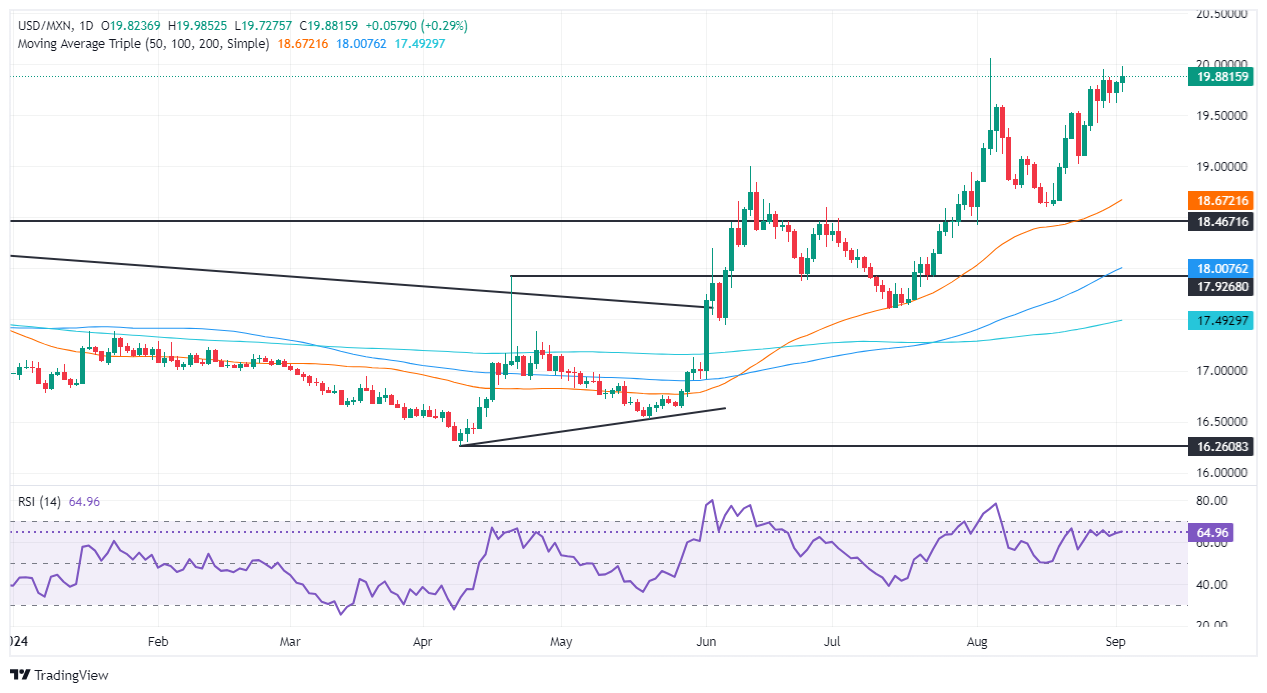- Mexican peso falls as Congress votes on controversial judicial reform.
- Morena’s supermajority is expected to approve the bill in the Chamber of Deputies, where they do not have a majority.
- Mexico’s unemployment rate rises in July, reflecting economic weakness.
The Mexican Peso posted losses for the second consecutive day against the Dollar, although it has recovered some ground. The USD/MXN fell from around 19.98 following the release of the US Institute for Supply Management (ISM) manufacturing PMI report. The USD/MXN is trading at 19.85 and gaining around 0.30% at the time of writing.
Political turmoil in Mexico is weighing on the Mexican currency as Congress prepares to vote on judicial reform, which foreign governments, Mexican justice system workers and multinational companies say, if approved, could threaten democracy and open the door for criminal organizations to infiltrate the courts.
Morena’s supermajority is expected to approve the bill in the Chamber of Deputies. However, in the Senate, Morena is still slightly short of achieving the majority needed to amend the Constitution.
In a related move, a judge granted a stay over the weekend to prevent debate on the proposal. The initiative has sparked a strike in the judicial sector, strained relations with the United States and shaken local markets amid widespread doubts it generates.
In July, Fitch Ratings commented that it could negatively affect investment appetite in Mexico.
In addition, President Andrés Manuel López Obrador has also pushed through bills to abolish autonomous bodies, such as the antitrust regulator and the Transparency Institute.
Mexico’s economic agenda included unemployment rate data, which showed an increase in the jobless rate, in line with the estimated rate, although higher than in June, according to the National Statistics Agency (INEGI).
Across the border, the US ISM manufacturing PMI remained in contraction territory, although the employment subcomponent improved compared to July data, which was welcomed by investors as Federal Reserve (Fed) officials had shifted to achieving the maximum employment mandate.
Daily Market Drivers Roundup: Mexican Peso Plunge as Economic Data Confirms Slowdown
- Mexico’s unemployment rate rose to 2.9% in July as expected, but was higher than June’s 2.8%. Seasonally adjusted figures showed the jobless rate remained unchanged at 2.7%.
- Monday’s data from Mexico showed an improvement in business confidence, while business activity deteriorated further as measured by the S&P Global manufacturing PMI.
- Most banks expect the Bank of Mexico (Banxico) to cut rates by at least 50 basis points (bps) for the remainder of 2024. This would put pressure on the Mexican currency, which has already depreciated 15.38% year-to-date (YTD).
- The ISM manufacturing PMI for August came in at 47.2, below estimates of 47.5 but above July’s 46.8. Meanwhile, the employment subcomponent index rose to 46.0 from 43.4.
- US nonfarm payrolls in August are expected to rise to 163,000 from 114,000, while the unemployment rate is forecast to fall to 4.2% from 4.3%.
- Data from the Chicago Board of Trade (CBOT) suggest the Fed will cut at least 96.5 basis points, based on the December 2024 federal funds rate futures contract.
Technical Outlook: Mexican Peso Plunge as USD/MXN Rises Above 19.80
The USD/MXN has a bullish bias, consolidating near the 19.50-20.00 area. The Relative Strength Index (RSI) is flat, although it remains bullish, indicating that momentum is showing further upside in the exotic pair.
If USD/MXN buyers break above the 20.00 figure, there are plenty of additional targets on the upside. The next resistance would be the yearly high at 20.22, followed by the September 28, 2022 daily high at 20.57. If those two levels give way, the next stop would be the August 2, 2022 high at 20.82, ahead of 21.00.
In case of further USD/MXN weakness, the first support would be 19.50. A break of the latter will expose the August 23 low at 19.02 before giving way to sellers looking to test the 50-day simple moving average (SMA) at 18.65.
Mexican Peso FAQs
The Mexican Peso is the legal currency of Mexico. The MXN is the most traded currency in Latin America and the third most traded currency in the Americas. The Mexican Peso is the first currency in the world to use the $ sign, prior to the later use of the Dollar. The Mexican Peso or MXN is divided into 100 cents.
Banxico is the Bank of Mexico, the country’s central bank. Created in 1925, it provides the national currency, the MXN, and its primary objective is to preserve its value over time. In addition, the Bank of Mexico manages the country’s international reserves, acts as a lender of last resort to the banking sector, and provides economic and financial advice to the government. Banxico uses the tools and techniques of monetary policy to achieve its objective.
When inflation is high, the value of the Mexican Peso (MXN) tends to decrease. This implies an increase in the cost of living for Mexicans, which affects their ability to invest and save. In general, inflation affects the Mexican economy because Mexico imports a significant amount of final consumer products, such as gas, fuel, food, clothing, etc., and a large amount of production inputs. On the other hand, the higher the inflation and debt, the less attractive the country is for investors.
The exchange rate between the USD and the MXN affects imports and exports between the United States and Mexico, potentially affecting demand and trade flows. The price of the Dollar against the Mexican Peso is affected by factors such as monetary policy, interest rates, the consumer price index, economic growth and some geopolitical decisions.
The exchange rate between the USD and the MXN affects imports and exports between the United States and Mexico, potentially affecting demand and trade flows. The price of the Dollar against the Mexican Peso is affected by factors such as monetary policy, interest rates, the consumer price index, economic growth and some geopolitical decisions.
Source: Fx Street
I am Joshua Winder, a senior-level journalist and editor at World Stock Market. I specialize in covering news related to the stock market and economic trends. With more than 8 years of experience in this field, I have become an expert in financial reporting.








